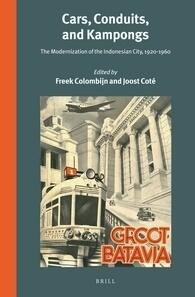
Cars, Conduits, and Kampongs: The Modernization of the Indonesian City, 1920-1960
Inga betyg ännu
Format
Inbunden
Sidor
351
Språk
Engelska
Publicerad
Oct 16, 2014
Förlag
Brill Academic Pub
ISBN-10
9004280693
ISBN-13
9789004280694
Beskrivning
This exploration delves into the transformative period of Indonesian urban life between 1920 and 1960, shedding light on the intricate interplay between modernization and local culture. Freek Colombijn and Joost Coté meticulously unravel how the rise of automobile culture, the development of infrastructure, and the dynamics of kampongs shaped the evolution of Indonesian cities. Their analysis offers a deep understanding of both the socio-economic changes and the cultural adaptations that occurred during this pivotal era.
As the authors navigate through historical contexts, they provide a rich tapestry that illustrates the impact of Western influences on Indonesian urban planning and lifestyle. The book captures the tensions inherent in modernization, particularly how traditional kampong communities responded to the encroachment of new technologies and urban frameworks. A keen focus on the interactions between different social groups reveals the complexity of identity and belonging in an evolving urban landscape.
Ultimately, this work serves as a vital contribution to the study of urban development and post-colonial history in Indonesia. It invites readers to reflect on how the remnants of this modernization period continue to influence contemporary urban challenges and aspirations within Indonesian society. Each chapter seamlessly blends historical narratives with socio-political insights, making it an essential read for those interested in the facets of urban transformation in Southeast Asia.
As the authors navigate through historical contexts, they provide a rich tapestry that illustrates the impact of Western influences on Indonesian urban planning and lifestyle. The book captures the tensions inherent in modernization, particularly how traditional kampong communities responded to the encroachment of new technologies and urban frameworks. A keen focus on the interactions between different social groups reveals the complexity of identity and belonging in an evolving urban landscape.
Ultimately, this work serves as a vital contribution to the study of urban development and post-colonial history in Indonesia. It invites readers to reflect on how the remnants of this modernization period continue to influence contemporary urban challenges and aspirations within Indonesian society. Each chapter seamlessly blends historical narratives with socio-political insights, making it an essential read for those interested in the facets of urban transformation in Southeast Asia.
Recensioner
Inga recensioner ännu
Bli den första att recensera denna bok och dela dina tankar
Lägg till första recensionenLäsdagbok
Inga läsloggar hittades
Börja spåra dina läsframsteg för att se loggar här
Lägg till din första läsloggAnteckningar
Inga anteckningar hittades
Börja skriva anteckningar för att se dem här
Lägg till din första anteckningTransaktionslogg
Inga transaktionsloggar hittades
Börja spåra dina boktransaktioner för att se loggar här
Lägg till din första transaktionslogg